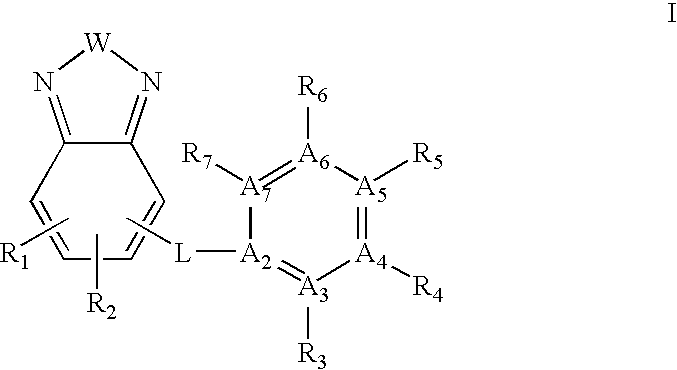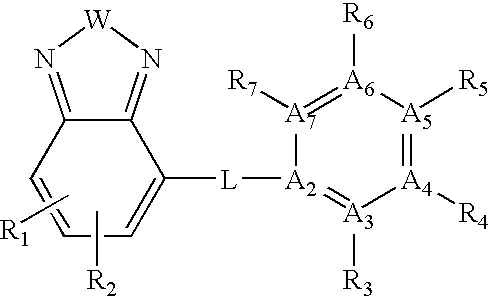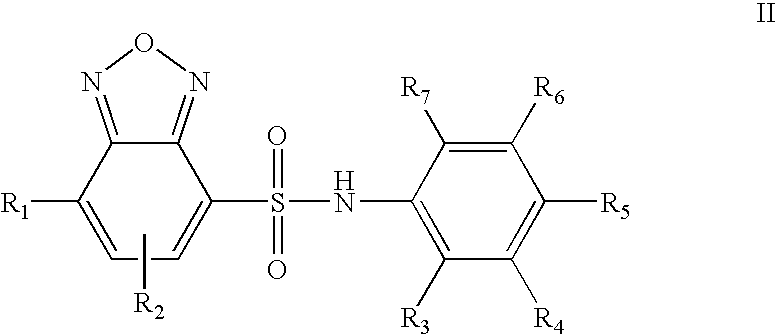Ubiquitin ligase inhibitors
- Summary
- Abstract
- Description
- Claims
- Application Information
AI Technical Summary
Benefits of technology
Problems solved by technology
Method used
Image
Examples
example 1
[0207]
Methyl 4-{[(7-chloro-2,1,3-benzoxadiazol-4-yl)sulfonyl]amino}benzoate (Cpd No. 8)
[0208] To 25.2 mg (0.1 m.mole) of 7-chloro-2,1,3-benzoxadiazole 4-sulfonylchloride was added 2 ml of dichoromethane and 50 mg of morpholino methyl polystyrene resin. The mixture was treated with 30.2 mg of methyl-p-amino benzoate. The mixture was shaken at room temperature for 5 hours at which time an examination of the reaction mixture by TLC indicated that all the sulfonyl chloride was consumed. The reaction was filtered and purified by radial silica-gel chromatography using 1:4 ethyl acetate:hexane as solvent to yield 34.8 mg (94.8% yield) of the desired product as a pale yellow solid.
[0209]1H NMR (CDCl3): δ 3.853 (s, 3H), 7.13 (d, 1H, J=8.5 Hz), 7.48 (d, 1H, J=8.5 Hz), 7.87 (d, 1H, J=6.9 Hz), 8.0 (d, 1H, J=6.9 Hz); LC / MS purity 100%. MS: M+1 and M-1 seen.
example 2
[0210]
Methyl 4-{[(7-{[4-(methoxycarbonyl)phenyl]amino}-2,1,3-benzoxadiazol-4-yl)sulfonyl]amino}benzoate (Cpd No. 9)
[0211] To 22 mg (0.877 m.mol) of methyl 4-{[(7-chloro-2,1,3-benzoxadiazol-4-yl)sulfonyl]amino}benzoate was added 1 ml of ethanol and 30 mg of methyl-p-amino benzoate and 1 drop of triethyl amine. The mixture was heated in a microwave reactor at 160° C. for 2 hours. The reaction was about 75% complete at this time. The heating was continued for a further 1 hour at which time there was no trace of starting material. The solvent was then evaporated and the residue purified using radial silica-gel chromatography using 1:4 EtOAc:hexane as solvent. The reaction yielded 32.5 mg 77% yield of the desired product.
[0212]1H NMR (CDCl3): δ 3.84 (s, 3H), 3.94 (s, 3H); 6.88 (d, 1H, J=7.8 Hz); 7.13 (d, 2H, J=8.7 Hz); 7.35 (d, 2H, J=8.7 Hz); 7.42 (s, 1H); 7.85 (d, 2H, J=8.7 Hz); 7.98 (d, 1H, J=7.8 Hz); 8.1 (d, 2H, J=8.7 Hz); LC / MS purity 100%. MS 481 (M−1) seen.
example 3
[0213]
8-[(7-Nitro-2,1,3-benzoxadiazol-4-yl)thio]quinoline (Cpd No. 5)
[0214] To 40 mg (0.2 mmol) of 4-chloro-7-nitro-2,1,3-benzoxadiazole was added 2 ml of DMF and 60 mg of potassium carbonate. To this reaction mixture was added 128 mg (4 equivalents) of 8-mercaptoquinoline. The reaction turned bright red. The reaction mixture was heated at 60° C. for 4 hrs. Examination of the reaction by TLC showed no starting material. The reaction mixture was pored into 100 ml of water and extracted with ethyl acetate and methylene chloride. The combined organic layers were dried and the solvent evaporated. The residue was purified by column chromatography on silica gel using 1:2 EtOAc:Hexane as eluant. The 8-[(7-nitro-2,1,3-benzoxadiazol-4-yl)thio]quinoline was obtained as a red solid. 48.9 mg (75.4% yield)
[0215]1H NMR (CDCl3): δ 6.45 (d, 1H, J=7.8 Hz); 7.55 (m, 1H); 7.7 (dd, 1H, J=7.8 and 1.5 Hz); 8.1 (dd, 2H, J=1.5 and 7.8 Hz); 8.2 (dd, 1H, J=1.5 and 7.8 Hz); 8.3 (dd, 1H, J=1.5 and 7.8 Hz); 8...
PUM
| Property | Measurement | Unit |
|---|---|---|
| Fraction | aaaaa | aaaaa |
| Volume | aaaaa | aaaaa |
| Volume | aaaaa | aaaaa |
Abstract
Description
Claims
Application Information
 Login to View More
Login to View More - R&D
- Intellectual Property
- Life Sciences
- Materials
- Tech Scout
- Unparalleled Data Quality
- Higher Quality Content
- 60% Fewer Hallucinations
Browse by: Latest US Patents, China's latest patents, Technical Efficacy Thesaurus, Application Domain, Technology Topic, Popular Technical Reports.
© 2025 PatSnap. All rights reserved.Legal|Privacy policy|Modern Slavery Act Transparency Statement|Sitemap|About US| Contact US: help@patsnap.com



